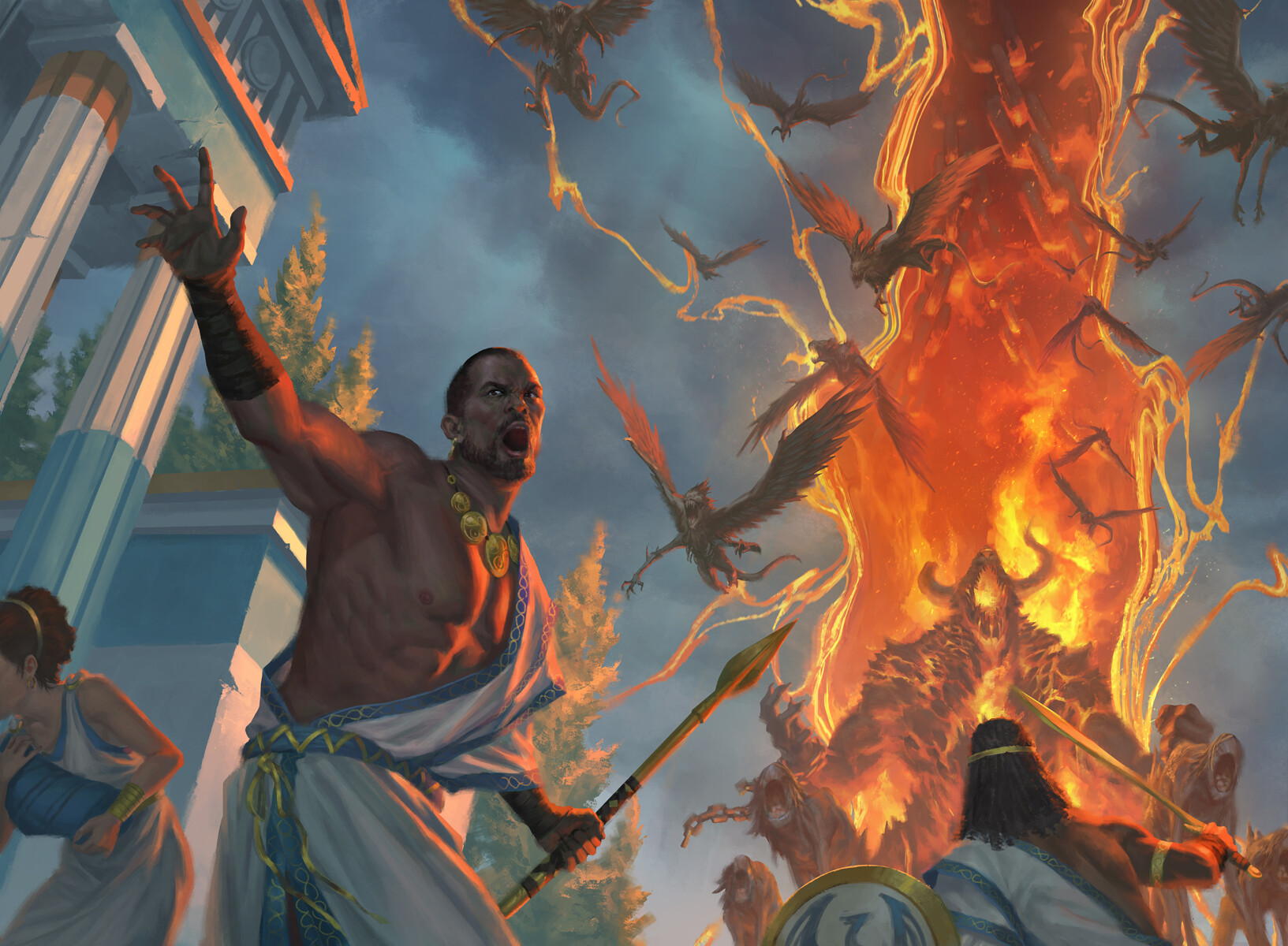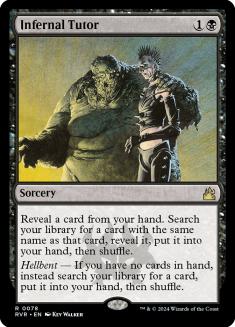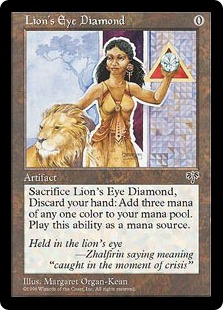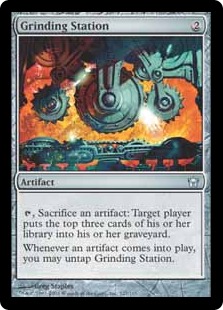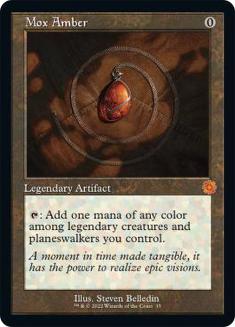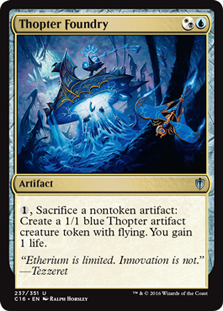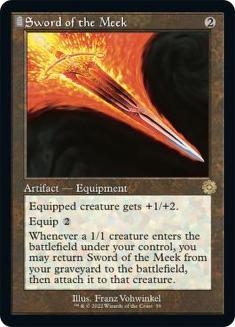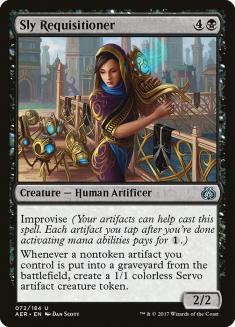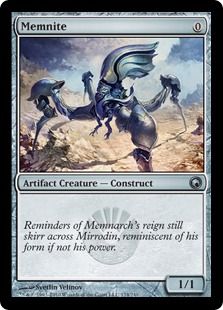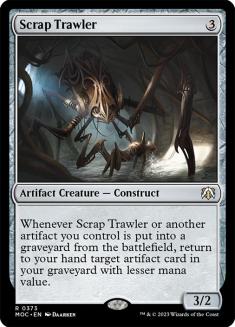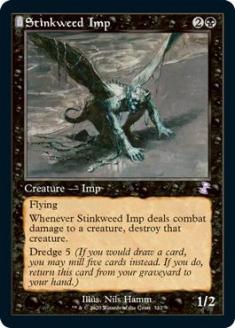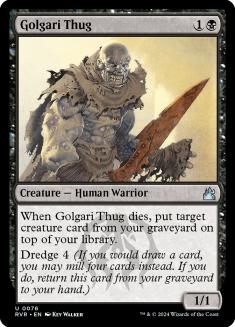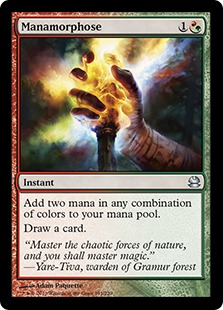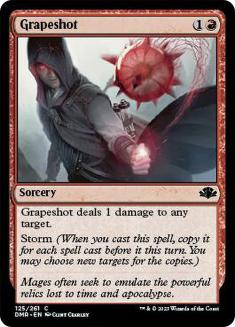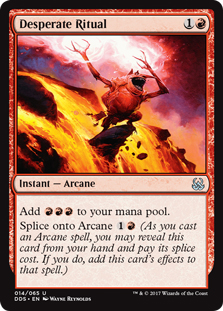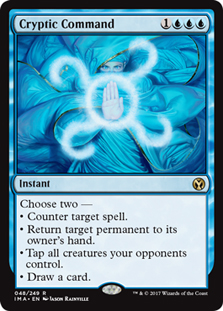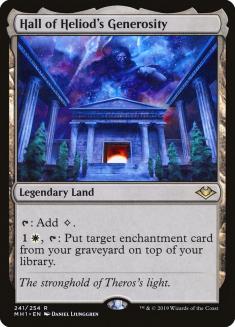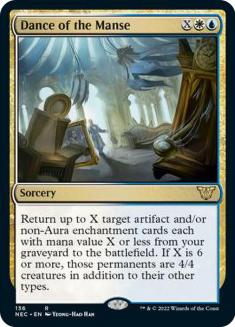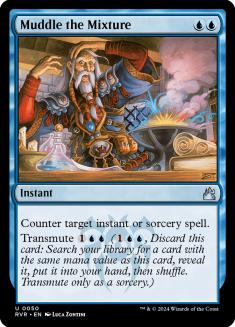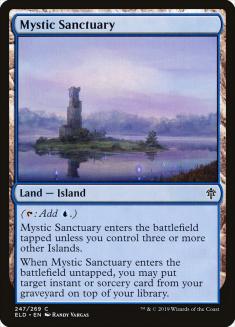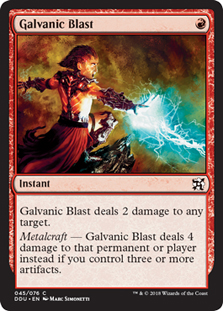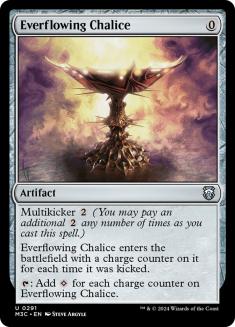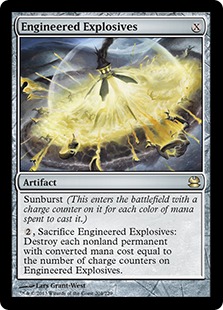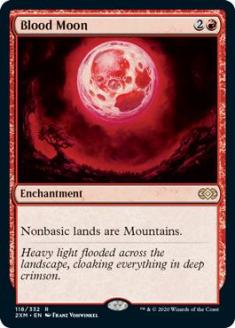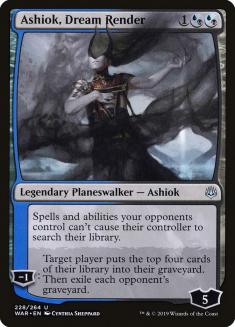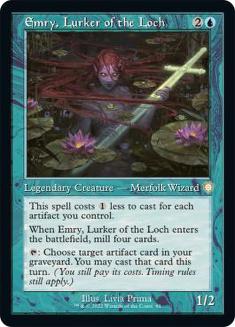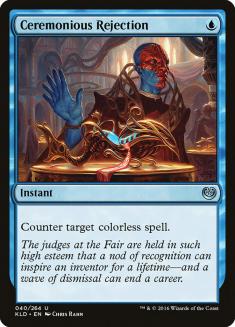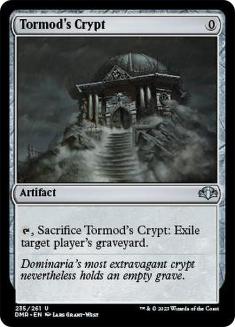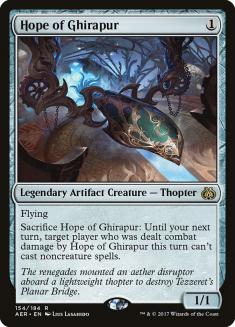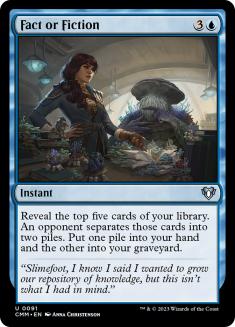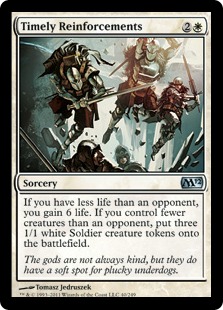I don’t think Underworld Breach is long for this Modern world.
Honestly, I don’t really think it should have a place in Pioneer or Legacy, either. Underworld Breach with Lotus Field is so warping, and Infernal Tutor + Lion’s Eye Diamond is just downright broken in Legacy, now that you can go find Underworld Breach and just win.
As for Modern, the key to breaking Underworld Breach is Grinding Station.
With a Grinding Station and an Underworld Breach, any zero-cost artifact can be used to loop. Say it’s a Mishra’s Bauble, or whatever.
When you cast the Mishra’s Bauble (possibly out of your graveyard), Grinding Station gets an untap trigger. You can Grinding Station yourself, milling yourself for three more cards, which means you can cast the Mishra’s Bauble out of your graveyard again. You can repeat this as many times as you want, eventually running yourself out of cards and winning with Thassa’s Oracle.
With an Emry, Lurker of the Loch or Teferi, Time Raveler, you can loop a Mox Amber, giving you more than enough mana to do whatever you want.
Our normal “goldfish” draw is casting Grinding Station on Turn 2, followed by Underworld Breach on Turn 3 with a mana to spare (which can be important for casting an Emry we eventually flip, letting us get the Amber party started).
In finding the best Grinding Breach deck for Regionals, this weekend, I looked at a few possibilities. One approach that looks really exciting to me is Ryan Bennett’s third-place list from the recent Classic in Indianapolis.
Creatures (13)
Lands (21)
Spells (26)

He’s combining so many combos here, and when the right balance is struck, I could easily imagine this turning into the prohibitively dominant deck of the format. That said, I’m not sure we’re gaining enough from all the various combos yet, compared to just playing more and better interaction, and focusing on being the best Grinding Breach deck we could be.
Thopter Foundry + Sword of the Meek is a sweet combo, to be sure, but it sure is vulnerable to all the same stuff that’s good against Grinding Breach anyway. If it really did speed us up enough or let us fight through interaction easily, it could be worth it.
Sly Requisitioner combines with Sword of the Meek and Grinding Station to loop. Each time a 1/1 gets made, you get the Sword of the Meek back, meaning there are two untap triggers for Grinding Station.
If you wanted even more combos, Memnite and Scrap Trawler can combine with Sword of the Meek and Grinding Station to win without the Requisitioner or Breach, as Sword of the Meek can keep getting back the Memnite.
Another approach to Underworld Breach I considered was a Dredge variant seeking to set up a Breach where we can use Manamorphose to turn any three cards in our graveyard into another card in our hand, which can in turn be used to Dredge four or more cards, thanks to Golgari Thugs and Stinkweed Imps. It’s not deterministic, but it doesn’t take all that much to get going sufficiently to be sure we’ve got enough.
Tome Scour can be looped so that for every mana you spend (and three cards you exile), you can mill five cards deeper, looking for Manamorphose.
Eventually, we go through our whole deck and kill with Grapeshot (which conveniently costs the two we’ve been spending on Manamorphose, though we do have Desperate Ritual for spots where we end up needing to get ahead on mana).
Creatures (16)
Lands (20)
Spells (24)
- 1 Desperate Ritual
- 1 Grapeshot
- 4 Manamorphose
- 4 Tome Scour
- 4 Shriekhorn
- 2 Infernal Plunge
- 4 Cathartic Reunion
- 4 Underworld Breach
Sideboard

While this style has the advantage of not being reliant on artifacts, it’s just so much more vulnerable to graveyard hate, and it doesn’t get to play much interaction. Besides, I think the Grinding Station draws are just too good to pass up.
For this weekend, I’m into a version of a Pascal Maynard’s Grinding Breach deck that’s fast, consistent, and resilient to disruption, and that gets to play a fair bit of good interaction. First, here’s the version of his deck that has rapidly gained notoriety:
Creatures (5)
Planeswalkers (3)
Lands (21)
Spells (31)

For starters, Galvanic Blast; Engineered Explosives; Metallic Rebuke; Teferi, Time Raveler; and Cryptic Command give us a lot of ways to solve problems. Underworld Breach being an enchantment is great here, as we can bounce it with Teferi, Time Raveler or Cryptic Command, ensuring we have it available again next turn. This is especially nice for doing little “value” Underworld Breach turns.
We’re even taking advantage of Underworld Breach’s “enchantment-ness” with the added staying power we get from Hall of Heliod’s Generosity, threatening to rebuy the busted enchantment at will.
We also have an exciting way to fight through removal in the form of Dance of the Manse:
Dance of the Manse is pretty fancy, but the most exciting play with it tends to be spending four to rebuy both Grinding Station and Underworld Breach. Of course, there’s nothing wrong with spending five, if we’ve got it, to get back a zero to help get us started. That said, one is probably plenty, as we can add Muddle the Mixture to give us more ways to access Dance in matchups where we’re looking to fight through removal.
If we ever mill a Muddle the Mixture, whether from Grinding Station or Emry, Lurker of the Loch, we can use a fetchland to find the Mystic Sanctuary. Besides, Muddle the Mixture is just super-cool in this deck anyway, giving us another form of interaction against combo and control decks that can double as a passable (albeit slow) tutor for either Grinding Station or Underworld Breach.
Mystic Sanctuary is a relatively low-opportunity-cost way to give us a little more gas later in the game, allowing us to use a fetchland to find it and ensure we draw something good next turn (most commonly Cryptic Command). It’s really slow, but you can Muddle the Mixture for half of the combo. Then you can fetch up the Sanctuary, put the Muddle back on top, and finally transmute it for the other half.
Here’s my update to the archetype:
Creatures (5)
Planeswalkers (3)
Lands (20)
Spells (32)

I wanted to try to do without green, though I’m definitely not sure we need to cut it out.
Here’s a breakdown of how I’d look to sideboard, though it’s important to remember to personalize your plan against the stuff you saw that seemed notable in your opponent’s deck. Modern has a lot of room for personalization, and sometimes one or two unusual maindeck or sideboard choices can radically change the value of one of the options we were considering taking out or putting in.
VS Amulet Titan
Out:
In:
Amulet Titan is one of the defining decks of the format, and at a baseline, we’re actually in a pretty decent position against them. Our A-game is slightly faster than theirs, plus we have better disruption. Once we get to add Blood Moon and Aether Gust, we’re looking pretty solid. That said, if they have access to Stony Silence, it could be a nightmare.
Whether to cut more Teferis or keep them all, cut more Explosives or keep them all, cut more Galvanic Blasts or keep them all – it’s really about figuring out how they’re planning to interact with us. Teferi is generally not great against versions that are really all-in on Primeval Titan (though it is quite exciting against a suspended Search for Tomorrow). The more three-cost creatures they play, however, the better it gets. Besides, it’s just such a strong card, it’s not like it’s ever that bad.
Similarly, Engineered Explosives might be really weak (say, against a Scapeshift variant) or it might be crucial (removing Rest in Peace or keeping them off of Dryad of the Ilysian Grove or Amulet of Vigor). It’s important to remember that the Dryad lets them play on through a Blood Moon, so we’ve got to get down to business quickly. They can’t Valakut kill us, and it messes up their bouncelands, but it’s not necessarily going to break their back.
VS Eldrazi Tron
Out:
In:
The biggest challenge we’ve got to overcome in this matchup is Chalice of the Void. A Chalice on zero leaves us unable to do our primary loops. It also messes up our primary form of interaction, as we won’t be able to Engineered Explosives for zero without Everflowing Chalice or Hall of Heliod’s Generosity (in which case, we can spend colorless mana and still get zero counters). This means we’re frequently going to want to cast Explosives on zero whenever we have the chance, such as Turn 1, on the play. That said, they could have access to Grafdigger’s Cage, so it’s not always right to just drop Explosives out there as soon as you draw it.
While a Chalice on zero is very disruptive, we do have both Teferi, Time Raveler and Cryptic Command to get Chalice of the Void off the battlefield. Besides, we can still cast Grinding Station and Underworld Breach to pretty great effect. If we find an Arcum’s Astrolabe, every mana we spend lets us draw a card and either mill our opponent for three or ourselves for an extra three more than we need to keep the combo going.
Eventually we’d need to target our opponent with more of the Grinding Station activations if we’re trying to win that way, but usually we’re just trying to mill ourselves all the way down to set up the Thassa’s Oracle kill.
Recasting Explosives for one over and over is less exciting, but it does let us look six cards deeper for every mana we spend, eventually finding Arcum’s Astrolabe so we can actually make a profit. Ideally we can find a spot in which we mill into Teferi or Cryptic Command with enough mana to let us use it and then switch back into looping zeros.
Blood Moon doesn’t mess them up nearly as much as it does a lot of other Urzatron decks; however, it can slow them down a little and turns off Scavenging Ground.
If we had access to another bounce spell, say Echoing Truth, I could see sideboarding it in here. And if we were playing a build with green mana for Veil of Summer, I kind of like one Ancient Grudge.
VS Dredge / Goryo’s Vengeance
Out:
In:
A common theme against opponents without a ton of removal is the removal of Dance of the Manse and, assuming they aren’t a sorcery/instant-based combo deck, Muddle the Mixture. They give us a nice method of playing through interaction, but if our opponents aren’t bringing much, it’s better to speed ourselves up.
Tormod’s Crypt is particularly awesome in these decks, as it can also function as a combo piece, giving us the zero we need to go off.
If the Goryo’s Vengeance deck has a heavy blue component, we’re also going to want to sideboard in the Mystical Dispute, maybe trimming a Cryptic Command if it seems a bit slow. Alternatively, if they’re playing Through the Breach, Aether Gust might not be too bad.
VS Other Urza decks
Out:
In:
Here, we’re mainly looking to slow down the game down a little and prepare to fight through a lot of permission. If you think they might have Teferi, Time Raveler, you’re probably going to want the extra Galvanic Blast. Engineered Explosives is awesome in this matchup anyway; but it’s especially important to keep in mind the possibility of something like Grafdigger’s Cage.
This is definitely a spot where Veil of Summer would be nice, and if you’re playing it, it’s definitely worth bringing in. While it’s nice to not need Breeding Pool (and for our Blood Moons to be that much better), we’re definitely paying the price a little here for having Ceremonious Rejection instead of Veil.
If they are playing Whir of Invention, Ashiok might actually be a nice option. It’s pretty solid against Goblin Engineer as well.
Despite their high artifact count, Ceremonious Rejection isn’t good enough against Urza decks because it doesn’t hit some of the cards that matter most, like Urza and Breach. Further, it doesn’t even counter Thopter Foundry (or Wishclaw Talisman, if they have it).
It’s important to remember in this matchup that Grinding Station untaps each time an artifact enters the battlefield, regardless of whether it’s on your side of the battlefield or your opponent’s.
VS Grinding Breach
Out:
In:
In a true mirror match (or a Dredge variant), Tormod’s Crypt becomes a real part of our plan. We’ve also got less interaction to fight through, and just need to slant for a faster game. If you can get the feeling that you want Tormod’s Crypt against the Urza player, that’s okay too (for instance, if they have Scrap Trawler).
VS Vizier of Remedies-based Collected Company
Out:
In:
This sort of assumes they are playing something more Vizier of Remedies / Devoted Druid-based. If they are mostly white Heliod, obviously skip the Aether Gusts.
While we do trim stuff like Everflowing Chalice in a fair number of matchups, it doesn’t mean they have to be wrong maindeck. Our Game 1s are going to generally be a little more race-centric, whereas the sideboard games are often going to involve more interaction on both sides.
Sideboarding out artifacts is especially solid against Collected Company decks, which are more likely than average to have access to cards like Stony Silence or Collector Ouphe.
Rest in Peace may seem intimidating, but we do have a lot of ways to get it off the battlefield between Explosives, Teferi, and Cryptic Command. I don’t think we want to actually put any dedicated Disenchant effects in our sideboard, as our sideboard slots are just so high-value and sideboarding in one-for-one removal spells like that reduces the amount of material we have to combo with. Besides, it’s not like those kinds of cards actually help us against their A-Game.
They’d have to be playing a pretty unusual, more extreme version of some kind of Melira version before Tormod’s Crypt could start to be an option. I think we’d actually be more likely to sideboard in Fact or Fiction, and kind of go the other way. If they seem to have a high amount of discard and removal, like Abrupt Decay and Assassin’s Trophy, then Fact or Fiction is the perfect way to fight them.
Lastly, if they’re playing Finale of Devastation, Ashiok, Dream Render might be sweet.
VS Stoneblade (Azorius, Bant, or more)
Out:
In:
There is so much personalization possible among the Stoneblade decks, we’re really going to need to make sure we’re considering all of our options between games, depending on what we saw.
VS Burn or Mono-Red Prowess
Out:
In:
I’m not positive that this is the right way to go about this one, but generally, I think we just want to try to be as fast as possible. It’s definitely possible that Cryptic Command is better than some amount of Metallic Rebuke or Everflowing Chalice.
VS Infect
Out:
In:
This matchup is going to be hard, however you slice it. They are just so fast and we’re not super-well-equipped to interact with them the right ways.
VS Merfolk
Out:
In:
I think the main thing we’ve got to remember against Merfolk is that they are going to put a pretty reasonable clock on us and then try to cover it with a little permission. This makes Muddle the Mixture and Dance of the Manse a little slow. I’m not thrilled with Cryptic Command, but we just don’t have enough cards to sideboard in. If you have Veil of Summer, this is a great spot for it.
VS Jund
Out:
In:
We’re usually going to want to sideboard more, but that depends on what they present. Aether Gust might be solid against Tireless Tracker and Kroxa, but is not what you want against Death’s Shadow. Galvanic Blast is great if they’re playing Dark Confidant, but not so good against Seasoned Pyromancer.
As for what else to cut, Metallic Rebuke is a fine option, as is Everflowing Chalice. Just make sure you don’t put too many reactive cards in, and prepare for a grind.
I don’t think Underworld Breach is long for this world, making SCG Regionals this weekend the perfect time to be part of the problem.

